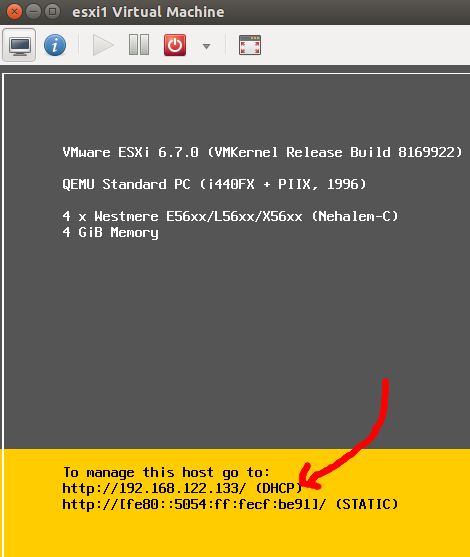

- #INSTALL OS X ON ESXI INSTALL#
- #INSTALL OS X ON ESXI DRIVER#
- #INSTALL OS X ON ESXI FULL#
- #INSTALL OS X ON ESXI SOFTWARE#
- #INSTALL OS X ON ESXI CODE#
If your host CPU is Intel, add this to the end of the “args” line: -cpu host,kvm=on,vendor=GenuineIntel,+kvm_pv_unhalt,+kvm_pv_eoi,+hypervisor,+invtsc (A USB keyboard is added here because macOS doesn’t support QEMU’s default PS/2 keyboard.) Ensure the args are all on a single line! Add this line, being sure to substitute the OSK you extracted earlier into the right place: args: -device isa-applesmc,osk="THE-OSK-YOU-EXTRACTED-GOES-HERE" -smbios type=2 -device usb-kbd,bus=ehci.0,port=2 First, SSH into your Proxmox server so we can make some edits to the configuration files.Įdit /etc/pve/qemu-server/nf (with nano or vim). In the Hardware page for the VM, add a second DVD drive at IDE0, set it to use your Catalina-installer.iso.ĭon’t try to start the VM just yet. In the Options page for the VM, ensure that “use tablet for pointer” is set to “Yes”.
#INSTALL OS X ON ESXI DRIVER#
Disable ballooning because there is no balloon driver available for macOS.

#INSTALL OS X ON ESXI CODE#
Save the first block of C code from this page as smc_read.c. You can get around this by reading an authentication key out of your real Mac hardware (the OSK key).

MacOS checks that it is running on real Mac hardware, and refuses to boot on third-party hardware. iso file extension, this is actually a hard disk image. This has several improvements over my old Clover-based tutorial, like fixes to screen resolution problems, better CPU feature support, and better FileVault compatibility, and is recommended for all future builds.ĭownload the latest release from my repository, unpack it, and upload it to Proxmox’s ISO store at /var/lib/vz/template/iso. We’ll be using OpenCore as a bootloader for Catalina. Building the offline installer requires you to have a Mac, here are the instructions. If you won’t have an Internet connection available to Catalina during installation, or your network can’t provide an IP address by DHCP you’ll need to build an offline installer instead. Upload the “ISO” to your Proxmox server’s ISO store (typically /var/lib/vz/template/iso). The result is actually a raw disk image, not a true ISO, but Proxmox has better tools for picking and re-using ISO images than disk images. Qemu-img convert BaseSystem.dmg -O raw Catalina-installer.iso # Or use qemu-img from the qemu-utils package to do it instead:
#INSTALL OS X ON ESXI INSTALL#
Or like so if you’re building this on Linux: # Install the dmg2img package and.ĭmg2img BaseSystem.dmg Catalina-installer.iso Convert that dmg into an “iso” like so if you’re building this on macOS: hdiutil convert BaseSystem.dmg -format UDRW -o Catalina-installer.iso This results in a ~500MB “BaseSystem.dmg” file in the current directory.
#INSTALL OS X ON ESXI SOFTWARE#
Download and run fetch-macOS.py in a terminal to download the Catalina recovery image from the Apple software distribution server (this can be run on Linux, Proxmox, or on a Mac): The easiest installer to build is a recovery image, which will download Catalina during installation. Modern AMD CPUs also support SSE 4.2 and will work with this guide. Older CPUs will cause the finder to repeatedly crash after installation completes (with an Illegal Instruction exception in the graphics code). Your Proxmox host computer’s CPU must support SSE 4.2, so for Intel your CPU must be at least as new as Nehalem, which was the first CPU generation to bear the “Core” i5/i7 branding. You also need a real Mac available in order to fetch the OSK key. I’ll assume you already have Proxmox 6.1 or 6.2 installed. If you’d like to use Clover instead, use my older tutorial, but OpenCore works better! Requirements
#INSTALL OS X ON ESXI FULL#
You can get the full sourcecode on my GitHub here. This tutorial for installing macOS Catalina using OpenCore has been adapted for Proxmox from Kholia’s OSX-KVM project and Leoyzen’s OpenCore configuration for KVM. MacOS 11 Big Sur has now been released! If you’d like that version instead then please use my new Big Sur installation guide!


 0 kommentar(er)
0 kommentar(er)
